The Power of Price
Have you thought about how to price your freelancing services lately?
Let’s me ask you candidly, as a freelancer, are you making the money you’re truly worth?
Chances are, you’re not. And if you’ve been freelancing for any significant amount of time, you’re probably starting to burn-out from an exhausting and frustrating race to the bottom.
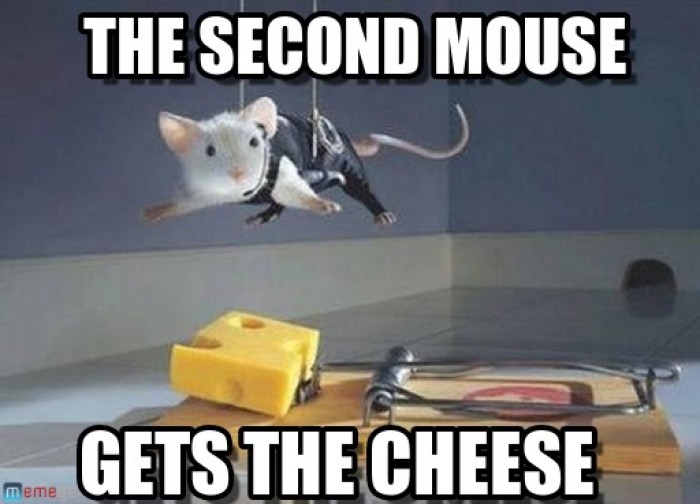
This isn’t uncommon, especially among new freelancers who often take any low-paying work they can get, just for an opportunity to prove themselves.
The first mistake these freelancers make is pricing themselves lower than the competition to win more customers. It might seem like the obvious thing to do, but the problem is – it works.
What ends up happening is you attract clients who want to pay very little, but expect a lot. The output on your end, in terms of time, energy, creativity, and focus is exponential compared to the value these clients bring.
Clients like these are “price shoppers” and simply put, they’re the worst. I know that sounds harsh, but clients who hire you based solely on your low price, require more convincing, more hand-holding and are, by far, the hardest to please.
They are also, overwhelmingly, the clients you attract when you underprice yourself. And most freelancers are exceptionally good at underpricing themselves.
Avoid clients who “price shop” – they are an enormous drain on your resources.
To make matters worse, the marketplace is flooded with low-paying clients who have unreasonable demands and discount freelancers who are trying to scratch out a living.

In the struggle to win more work, new freelancers often continue to cut their prices until the volume of work they must complete to satisfy their financial obligations is utterly unreasonable. If you’re output is unrealistically high, the quality of your work will suffer. And you’ll keep attracting low-quality clients, too.
It’s easy to be sucked into the downward pull of continuously cutting your prices ever lower to beat the competition, but it’s an unsustainable way to build your freelance business. And it’s something I’m all too familiar with – I know first-hand what an unforgiving trap it is.
It’s a guaranteed way to quickly face-plant your freelance career.
But here’s the thing – you have absolute control over attracting the best clients – your personal dream clients – through the power of price.
It’s a very simple concept: what you charge for your service gives you power in your business. Not like, world domination power, but rather the power to buy the time you need to produce the very best work you can for clients who will value it.
Power of Price:
What you charge for your service gives you power in your business.
By making simple adjustments to your mindset, your service structure and your pricing model, you will attract your dream clients and start earning higher income.
Who are your dream clients? Well, they’ll be different for everyone. You’ll need to define them for yourself based on your own business goals, but generally speaking, dream clients are clients whose needs are perfectly matched to your skills, and are happy to pay a premium price for what you’re offering.
When you attract your dream clients, it becomes easy to deliver your best work and build your business.
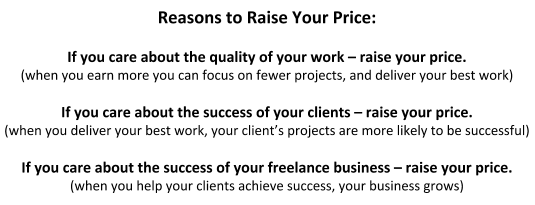
Successful freelancers have figured out how to avoid attracting difficult, low-paying clients. These freelancers charge a premium price for their services. Then, something magical happens: they are free to devote more time to the flawless execution of each project, which enables them to deliver great results, which builds their stellar reputation – and earns them even higher-paying business.
True story – when I started freelancing, I charged around $300 for something I now get paid $5,000 to do. So, how have I been able to drastically increase my price since my humble beginnings? It’s not that I’ve become drastically that much better at what I do.
No, it’s simply this: I figured out how to get paid what I’m worth.
By using some basic business math and rethinking my service offerings, I’ve managed to position myself better as a service provider and command higher prices while attracting my dream clients.
I want to emphasize that raising your price is not about tricking your clients into paying more. It’s about valuing your clients enough to set a price that enables you to provide them with the best service and highest quality work.
Set a price that enables you to provide your clients with the best service and highest quality work.
Your freelance business is dependent not only on the quality of your work, but also on the quality of your professional relationships. Delivering your highest quality work to your dream clients is the key to building a great reputation and a solid position.
So, how do you go about setting a price for your service? Let’s tackle that next.
How to Price Your Service
One of the key factors in determining your pricing model will be having a clear understanding of how much income you need to meet your financial goals.
By charging a fee that allows you to eliminate financial stressors and work at a comfortable pace, you’ll find it easier (and more enjoyable!) to do your best work.
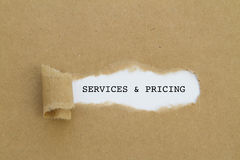
As a creative person, it is very difficult to do my best work if I am distracted. Instead, I like to have an “empty mind” – which is to say, a mind completely free from worry and able to focus exclusively on my client’s project.
If I’m worried about bills and cash flow, then turning on my creativity is very challenging, and my work suffers. So, because I care about my client’s success and the quality of my work, I have developed a pricing model that allows me to have an empty mind to create my highest quality work.
I like to think of my pricing strategy like this: the price I set for my services determines my profit margin. My profit directly represents the time I can afford to stay focused and centered on my client’s project. Therefore, the higher my price, the more profit I have, the more creative my empty mind can be, and the better job I can do for my client.
And when my ability to serve my clients increases and I become more valuable to them, I can raise my prices.
The price you set determines the profit you make,
the profit you make determines the energy you can devote,
the energy you can devote determines your ability to offer the best service.
How much money will it take to give you an empty mind free from financial worry? You may not be able to charge this price at first, but it should be your upward goal as you gain more experience.
So, when you are thinking about how to price your service, consider your current abilities along with how you want to position your business within the market.
The concept of base positioning may be helpful as you work through developing your pricing model.
Base Positioning Matrix
The Base Positioning Matrix has been around for some time and is a simple concept to understand. Basically, it breaks down service providers along the lines of quality, speed and price.
The idea is: you can be bad, fast and cheap or you can be good, slow and cheap, or you can be good, fast, and expensive.
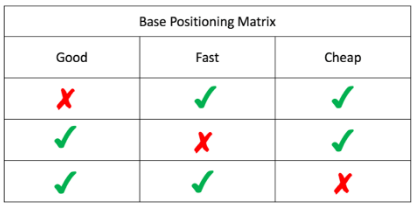
Bad, Fast and Cheap
If you are just starting out, and trying to develop a new skill, I recommend that you position yourself as fast and cheap, but not necessarily very good. It’s OK to be very fast and very cheap, but not very good when you are learning a skill. The goal here would be to learn the skill quickly and move up to being better so you can charge higher rates.
Good, Slow and Cheap
Positioning yourself as good but not very fast will give you more flexibility with your time but won’t allow you command higher rates. Still, this position is a good fit for some people, it all depends what you’re looking for.
Good, Fast and Expensive
This is the prime place to be – good, fast and expensive. Here is where you’ll see the highest rates as a freelancer. You don’t have to work at record-breaking speeds, but you’ll need to provide reasonable turnaround times and meet deadlines.
So, you can see that in addition to price being power, there is also a hierarchy to setting your price by determining the position your business will occupy within the market.
Setting a price that is high enough to give you the freedom to produce the best work is only one piece of the puzzle. Once you know how much you need to make, it’s time to get smart about how you package your service. With some simple, creative marketing strategies, you may find yourself making more money and doing less work.
In the next chapter, we’ll cover ways to deconstruct your service package to increase your income while doing less, and reaching a wider audience.
How to Offer More and Make More (Deconstruct your Service Package)
When you only offer one service, you miss an opportunity to serve a wider market and meet clients where they are facing challenges.
What a client needs, isn’t usually the exact thing you are offering, but rather something slightly above, below or to the side of that thing. So, instead of offering one service with multiple parts, unpack that service and offer more solutions. Addressing a wider range of client needs puts you in a better position to win more contracts.

Consider this, if your specialty is generating traffic, and that’s the one single service you offer, for, let’s say $2,000 a month, then you’re missing out on attracting clients who don’t need, or aren’t ready to purchase that level of service.
If you only offer the big-ticket item you’ll find many clients will be thinking, “Holy cow, I don’t have $2,000 a month to pay you right now. I only have like, $100. What can I do for $100?” If you don’t have anything else to offer, you’ll miss out on the opportunity to serve those clients.
Ryan Deiss, founder and CEO of DigitalMarketer, has an interesting take on this which has become popular with marketers. He calls it “State A to State B”.
It describes the transition of clients from a state of pain and frustration, to a state of happiness through the services you provide. This doesn’t happen overnight. A series of steps is needed to make the transition possible.
Offering these steps as separate services will allow you to create more income opportunities while addressing the actual pain points your potential clients are facing.

For instance, if your specialty is increasing website traffic, don’t say “I’m going to help you get more traffic and my service fee is $2,000 a month.” Instead, say, “I will charge you X dollars to set up your Facebook page, or I’ll charge you X dollars to optimize your ads.”
When you break up your service into these smaller options, you are creating micro-commitments that can be priced individually.
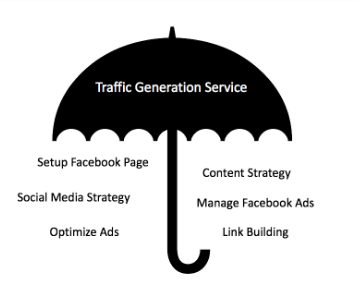
You might only charge $100 to set up a Facebook page, but you charge $1,000, $2,000 to set up their Facebook ads. Then, maybe you also offer management of those Facebook ads for $1,500 a month. Now your potential clients have a tier of service options to choose from, and can pick the one that they most need.
Now, by offering smaller services within the arc of your larger service, you can earn more money by charging for each smaller service individually, and adjusting your fee to create larger profit margins. By breaking it into different pieces, you can add markup instantly.
When you break up your service into these smaller options, you are creating micro-commitments that can be priced individually with instant added markup.
You’ll also be meeting your client’s most pressing needs, whether they need help creating their Facebook page or just help managing their ads.
So, why does a micro-commitment model work so well? It works because it responds to marketplace conditions. Let me share with you the philosophy of the lazy fisherman.
The Lazy Fisherman: Responding to Marketplace Conditions
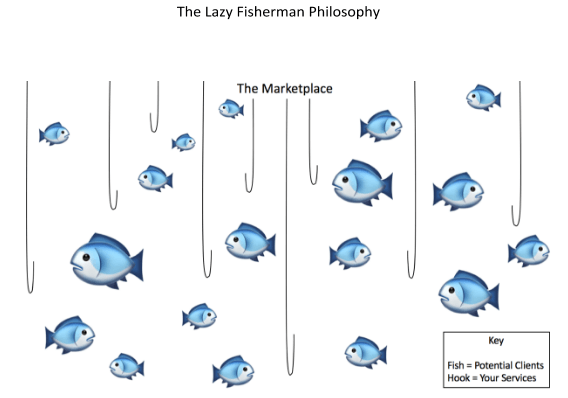
The fish represent your potential clients. Notice how they are all different sizes and heading in different directions at different depths?
The hooks represent your service offerings. Notice how there are many hooks are in the water, at different depths and facing different directions?
This is how the lazy fisherman snags fish – multiple hooks, each appropriate for a different fish. And this is how you should set up your freelance offerings.
When you act like a lazy fisherman and put many hooks in the water, you can extract more revenue from the market by increasing your ability to serve more people.
The idea is simple, meet your prospects wherever they are in their business journey, and offer them solutions that will convert them into customers.
Clients who have already invested in services to build their business and have some of the work they need complete, have demonstrated that they are more serious about collaborating and more committed to the success of their project.
And bonus: they are more likely to be able to afford you.
Clients who already have some of the work the need done are more likely to have the money to pay higher prices for your work.
If you are a freelancer who only offers one service, it’s like having only one hook in the water. The odds are against you as a freelancer when you go with just one hook. To snag a client, your one hook must be at the right depth, and loaded with the right bait to even have a chance at attracting a fish going in the right direction.

Many freelancers who are just starting out, and only offer one service, tend to target clients who are also beginners themselves, which leads to low-paying projects. That’s because these freelancers have not yet realized that many of their potential clients are not necessarily beginners, and are further along in their individual projects.
If there are ten steps involved in transforming a client from State A to State B, target individuals at every step. Target the person who is at step four and help them get to step six, or seven or wherever they want to be. Target the person at step nine and give them that final push to make it to step ten.
When you do this, regardless of your marketing mechanism, regardless of whoever your audience is, you can reach more people, solve more problems, and make more money.
How to Offer More and Do Less: Automating and Outsourcing
Breaking up your service into micro-commitments doesn’t mean you must do everything yourself. In fact, you shouldn’t. Unless your goal is to work non-stop, there is no reason to build a business model that requires you to do everything. Instead, figure out what you like to do and what you can charge the most for, and automate or outsource the rest.
Here’s what I mean: let’s say that you are an expert at making YouTube videos so you decide you’re going to focus on helping people make funny videos for their business.
Instead of saying “I’m the funny YouTube video guy, and I’ll help you get from A to B by doing everything for you,” break this service into individual offerings.
Do this by understanding the steps needed to take your clients from sad to happy, from State A to State B, and package those steps individually.
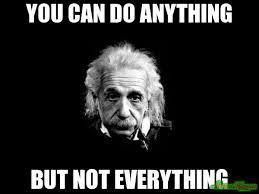
Let’s breakdown funny YouTube video guy’s service offerings:
To move client from State A to State B, funny YouTube video guy is offering a comprehensive, package that helps clients make videos for their business. His service includes:
- Content Strategy & Development
- Video Script Creation
- Video Editing
- Video Slides
In this scenario, Funny YouTube Guy is offering to do all the work for $2,000.
But maybe his clients already have some of the work they need complete. Maybe they only need one of the services he is offering within his complete package. And maybe Funny YouTube Guy would prefer to focus mainly on editing videos.
Well, one thing he can do, is offer each task as a stand-alone service and creatively develop ways to deliver value without doing additional work.
For example, let’s say he offers content strategy and development as a stand-alone service and prices it at, $250. Then, he can outsource that piece of his business someone who is highly skilled in content strategy and development.
Alternatively, or simultaneously, Funny YouTube Guy could develop an eBook that teaches his clients how to develop their own content strategy and write their own content. The price for a do-it-yourself component will be significantly lower, maybe $15 or $20, but it will be easy to scale without any additional work.
Now, just by making content strategy and creation a stand-alone service, Funny YouTube Guy has created two new separate streams of revenue while expanding his solution offerings to a wider audience.
Outsource micro-commitments to focus on what you enjoy doing most.
Automate your revenue by offering do-it-yourself solutions like eBooks and prerecorded video workshops.
The same approach can be taken with each component of his larger service:
- Video script creation, for instance, can also be outsourced. Or, Funny YouTube Guy could again teach clients how to do this work themselves. He could develop an eBook or he could even offer a free workshop that has built-in lead collection.
- Perhaps in this scenario, when prospects choose the do-it-yourself option for video script creation they’ll be offered an upsell for a professional script critique so they can be sure they’re on the right track. The critique can be priced individually, at maybe $200, with a secondary, more expensive upsell offer, priced at maybe $500 or $1000, where he’ll edit their script for them (but they’ve done most of the hard work already).
- Video editing is the one task Funny YouTube Guy wants to be most focused on, so perhaps he takes this on for himself and uses the same outsourcing/automating approach to package the video slide creation component of his service.
By breaking his service into micro-commitments and pricing them individually, Funny YouTube Guy has created many multiple opportunities for revenue, increased his service offerings and his ability to serve more clients.
Through outsourcing and automation, he has also created a way to work on the one service component he most enjoys while freeing up more of his time.
Here’s another bonus to the micro-commitment model: it’s the quickest long road to success around.
Let me explain.
The Long Way to Quicker Success: Business Math (aka Greasy Math)
We are living at the fastest pace in history. Everything is getting faster all the time. We don’t even talk in full sentences anymore.
We want the things we want, and we want them Right Now. Instant gratification.
This desire for speed can sometimes trip us up as freelancers. We want to make a sale as quickly as possible, but in making a quick sale we miss important opportunities.
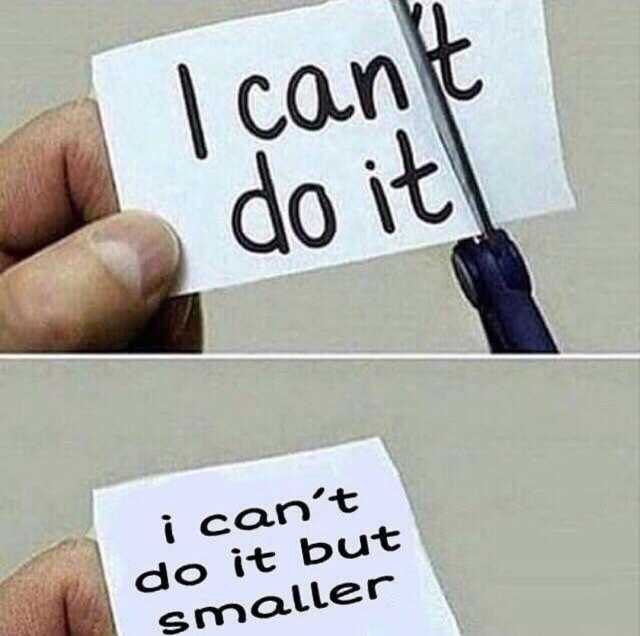
But here’s a thought –
What if delaying the sale of your main service, results in a faster way to build a more profitable, more controlled freelance business?
When you apply the concept of greasy math to your business, it may seem like you’re adding components that would slow down the purchase process. The truth is, greasy math is all about greasing the wheels to make it easier for a client to make a purchase – or many purchases.
The concept of greasy math is about creating multiple opportunities for revenue on the back-end so you can scale your business quickly and efficiently. Setting up back-end opportunities also enables you to qualify your client to ensure you are a good fit for project collaboration, while giving the client a chance to feel confident about you as a reliable service provider.
Let’s take a moment to define what a front-end sale looks like vs a back-end sale.
A front-end sale is the initial purchase made by your client. So, if you are a freelancer who only offers only one service, you have a front-end, single service business model, and only one opportunity to serve your client. Which means your opportunity to earn revenue is very limited. Your service model would look something like this:

Why is it a bad idea to develop a business that exclusively relies on front-end sales?
Well, in addition to the limited revenue potential, you are asking your prospect to make a significant purchase – your expensive main service, without warming them up first.
You haven’t built a relationship or created value yet, which makes it very difficult for them to have the trust or confidence necessary to invest in your service.

If we think of this as a dating analogy, it would be like meeting someone and asking them to marry you on the first date. Probably not going to happen, and if it does, that might be even scarier! This business model makes it impossible for you as a freelancer to filter out potential bad clients, as there is simply no opportunity to do so.
Drawbacks of the front-end, single service model:
- Limited revenue potential
- Requires prospect to make a significant purchase without first building trust
- Does not give you an opportunity to filter out bad clients
Ok, so, now let’s look at the back-end sale and multiple service model. Earlier, we learned that as a freelancer, you should be offering multiple services, or micro-commitments, rather than one larger service. Your service model should look something like this:
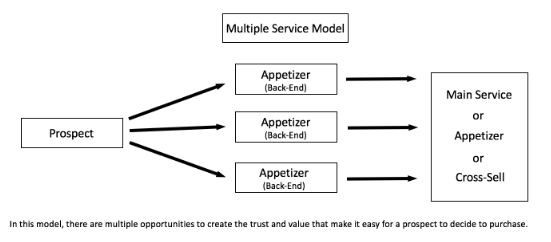
In the back-end sales model, we can see that our micro-commitments are “appetizer-sized” offerings. They cost less, provide value, and make it easier for your prospect to decide to make a purchase. And when they purchase an appetizer, they also reveal themselves as potential good clients for your main service, or an additional appetizer, or a cross-sell.
Think of these appetizer-sized offerings as the “math” part of greasy math. They scale easily, cost less and establish mutual trust.
The “grease” is really the appeal these lower-cost, bite-sized offerings have for your prospective clients.
Imagine that your prospective clients are on a slide. They’re all sliding towards either you or your competition or towards choosing nothing at all (don’t forget, you must also compete with prospects who choose to do nothing).
Grease that slide by offering more mini-solutions and making it easier for those prospects to invest in your service. As they make additional purchases, they will identify themselves as good candidates to pitch your main service to.

You’ll be able to qualify clients for your main service by filtering them through a system of smaller appetizers before you even allow them to see your main offerings.
You can think of it sort of like the dating analogy again, only in this version you court your partner, and go on multiple dates before tying the knot.
Rather than relying on a one prospect/one service model, develop a model that offers multiple smaller services and increases the number of opportunities to build a relationship, earn revenue, and eventually lead your client to a larger commitment.
And that is really the whole concept of greasy math.
By offering only smaller services at first, you make it easier for good clients to buy your main service more quickly.
So, what makes a good client anyway?

Work Exclusively with Good Clients
When you enter a relationship with a client, you want to be absolutely certain that they are competent. If you rush through the sale process and attract bad clients your business will suffer. This is true because, as a freelancer, you will only ever be as good as your client allows you to be.
As a freelancer, will only ever be as good as your client allows you to be.
Here’s why – let’s say you offer social media marketing, that makes you responsible for 5% of the overall success of your client’s marketing strategy.
After some time working with your client, you might see that you’re not getting good results, and your client is becoming upset. You may be thinking “I just don’t understand, I’ve followed all my training, I’ve done everything right, and I’m just not seeing any results.”
You may even be tempted to compare yourself to successful freelancers in your field and wonder why they are able to get such great results. Are they that much better than you? The answer, of course, is no.
They may be more experienced, but what truly sets them apart, is their ability to qualify prospects. They choose to work with only the best clients who will allow them to be successful.
So, they are.
Only work with qualified clients –
clients who have demonstrated they are a good fit.
If you’re doing a great job and you’re still not able to get the results you want for your client, you’re most likely not the problem.
The problem is almost certainly that your client isn’t doing a good job at preparing the other 95% of their business for your efforts. This is a bad client, and there’s no way for you to have a successful collaboration.
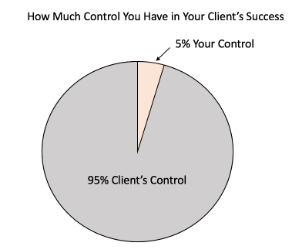
With an itty-bitty 5% control in this client’s marketing strategy, if the other 95% is dysfunctional, the odds are stacked against you, and your chances for success are practically nonexistent.
When most of a client’s business is not working properly, no matter what you do with your little sliver of the pie, you’re not going to see great results. In those cases, the problem isn’t with you, but with the 95% of the pie that isn’t working.
That’s why it’s so critically important to make sure you are working with quality clients who are ready to receive your work. This is how you become successful as a freelancer – delivering quality work to quality clients.
Now, just because someone reveals themselves to be unqualified for your main service, doesn’t mean they won’t eventually be qualified. They may just not be quite ready to work at the high-level needed for you both to be successful. You can use the appetizer process to help them become qualified at some later point, by offering them smaller services until they are ready for your main service.
Offer Good Clients the Best Perks for Big Purchases
When clients are qualified, and have revealed themselves as a good investment of your time, you are able to offer them better perks, like a money back guarantee. This is something I would NEVER offer to an unqualified client because it is far too risky.
For clients who have purchased some appetizer services and are ready to make a bigger purchase of your main service, the risk of them being unsatisfied is much smaller. And, offering a money back guarantee means you can charge more for your service because it helps your client overcome any fear or objection of making the purchase.
So, by now, you should a clear understanding of:
- How your price determines your ability to do your best work for the best clients
- Why you should avoid clients who “price shop”
- The concept of the base positioning matrix
- How to add instant markup by deconstructing your service package
- The concept of greasy math and how it can attract prospects and increase revenue
- How front-end and back-end sales models work
- The difference between good clients and bad clients (and why you should only ever work with good clients)
Now, let’s talk about how to convince prospects to invest in your service.
Let’s talk about obscene offers.
Attraction Marketing & Obscene Offers
How do you create offers that convince your prospect to purchase whatever you’re selling?
Well, in short, it’s all about making it easy for people to say “yes” to your service.
Before we dive into the exact formula that explains how to create an obscene offer, let me first introduce a concept made popular by Ed Meyer.
In the 1930’s and ‘40’s, Ed was a direct response copywriter, and he developed a concept known as the 40-40-20 Rule. The rule states that the success of any money-making venture is 40% dependent on the audience, 40% dependent the offer and 20% dependent on the creative design and copy.
Let’s look at each of these separately.
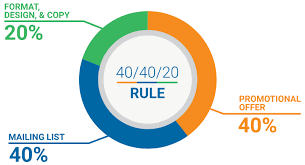
40% Audience
You probably already know how important the right audience is. You want to focus on engaging with people who are actually interested in what you can offer. It’s easier to sell water to a person who is thirsty, than a person who is not thirsty. Find an audience who is thirsty for what you’re offering. People who need your solution are more inclined to purchase your solution, it’s just that simple.
40% Offer
Anyone who trades services for money can learn to create irresistible offers that bring clients right to you. This is where the obscene offer comes in (more on that in a minute).
20% Creative Design and Copy
Surprising to many, only 20% of success is dependent on the creative components of your service. That means, if you burn through 10 hours trying to write the perfect paragraph, you should rethink the time you’re spending (or wasting). More time and effort should be committed to finding the right audience and creating the right offer.
The success of an obscene offer depends on not only what is being offered, but also the structure of the offer. It’s not about price.
An obscene offer is not about price.
The obscene offer has been used effectively as a marketing tool by service-based business for decades. It can give you a massive leverage point in closing a deal. It makes it nearly impossible for the person exposed to the offer to say no, because they actually have something to lose by saying no. It’s an offer so powerful, they are compelled to take it.
First, let me give you an example of what an obscene offer is not.
If I say, “I will run your Facebook ads for $2,000 a month”.
That offer is extremely easy to say no to. There is nothing compelling about that offer, it’s not interesting, and it’s easy to ignore.
When you make an offer like this, it doesn’t matter how many prospects you pitch it to, you’ve made it too easy for them to say no. You will not have good results.
Now, let me give you an example of an obscene offer.
If I say, “I will run your Facebook ads, lower your costs by 25%, and increasing your leads, or you’ll pay nothing until I do”.
That is an obscene offer. It is provocative and elicits a response. It makes your prospect pause long enough to consider your proposition, which they’ll find so irresistible, and so stacked in their favor, they’ll be hooked.
Now, your offer doesn’t have to be as extreme as the example here, but it should be meaningful to the prospect.
If you want to use attraction marketing and have prospects coming to you rather than submitting bid proposals and begging for jobs, then the way to do that is by creating an obscene offer for your service.
The formula for creating an obscene offer is this: “I promise to X or I will Y”.

There are two major points to understand:
- When you create an obscene offer, you must fully understand your own skill level and capabilities, and only make a promise you are confident you can deliver on.
- The “or I will” part of your obscene offer must be painful for you. It must be something your prospect will understand as a safeguard to ensure that you deliver on your promise or you else you’ll suffer the consequences.
With an obscene offer, you’ll become attractive to a certain type of prospect. You’ll attract more experienced individuals who have a solid, significant businesses.
Those who will be attracted to your obscene offer, will often be those who have had disappointing experiences with freelancers in the past. These people will be attracted because your offer has built-in accountability.
You’ll be effectively saying, “Look, I’m promising you pretty much the same thing as everybody else, but I’m willing to take the sacrifice to punish myself if we can’t get you results”.
When you set your offer up this way, you put yourself on the same team as your client. Now you’re both invested in a successful outcome.
It is important that you make sure your obscene offer is only reaching the right people (remember, you can only be as good as your client allows you to be).
Be picky about who can purchase your obscene offer – about who gets to take advantage of your promise.
If you are trying to build a freelance service-based business, then you can only promise what you can deliver, and you must be choosy about who you make that promise to, because service delivery is about 60% the responsibility of the client.
Service delivery is about 60% the responsibility of the client.
What I mean is, if you’re a logo designer and your obscene offer is “I’ll create a finished logo in 24 hours or you don’t pay”, then you must be certain that the only people you offer that promise to are those who have demonstrated an excellent ability to communicate (perhaps you’ve pre-qualified them with appetizer-sized services).
Otherwise, you would be running a high risk of failure, by taking a chance on an unknown or sub-par prospect.
When you create your obscene offer, have your best client in mind. Write for your dream client – the client who has resources, pays well, gives you creative freedom and is great at communicating.
The client is a giant part of your success as a freelancer, and your ability to say “no” to the prospects who can’t contribute to your success is critical.
The goal of your obscene offer, and really the key to your success as a freelancer, is to attract many prospects and then hand select the ones who will enable you to be successful.
Conclusion
Hopefully you are reaching this conclusion armed with some new tools to help you elevate your freelance career.
If you think back to the power of price and how earning enough to have peace of mind advances your ability to deliver great results for your clients, which in turn enables you to raise your price, and attract more great clients, well, that circular strategy all starts with an amazing obscene offer.
Take your time to apply these strategies in a manner that works best for you. Patience and forethought upfront will help you achieve greater success further down the road.
Want more? Check out this How-To Case Study video training where I dive into these topics even more!





